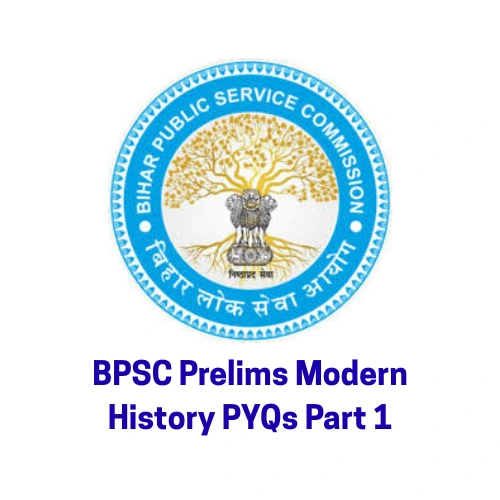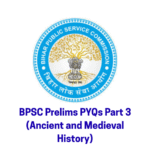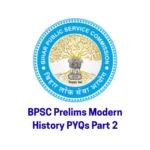Modern History forms a crucial portion of the BPSC Prelims. Questions usually cover the period from the advent of Europeans in India to the freedom struggle and independence of 1947. The BPSC Prelims Modern History PYQs Part 1 focus on major events, personalities, and socio-political developments.
- Advent of Europeans: Arrival of Portuguese, Dutch, French, and British.
- British Expansion & Policies: Battles of Plassey and Buxar and British administration.
- Social & Religious Reform Movements: Contributions of Raja Ram Mohan Roy, Ishwar Chandra Vidyasagar.
- Peasant & Tribal Movements: Santhal Rebellion, Indigo Revolt, Munda Movement, and others.
- Revolt of 1857: Causes, leaders (with Bihar-specific focus on Kunwar Singh).
- National Movement: Moderates, Extremist, Home Rule, Gandhian movements.
- Revolutionary & Leftist Movements: HSRA, INA, and role of Subhas Chandra Bose.
- Bihar’s Role in Freedom Struggle: Champaran Satyagraha, Quit India Movement in Bihar.
BPSC Prelims Modern History PYQs Part 1
The Tribal Movement-Santhal hool (Rebellion) took place in:
(a) 1857-58
(b) 1858-59
(c) 1855-56
(d) 1854
Ans: (c) 1855-56
The Vernacular Press Act allowed
(a) Confiscation of the assets of the newspaper if the newspapers published anything that was found objectionable
(b) Confiscation of the printing press if the newspapers published anything that was not found to be objectionable
(c) Confiscation of the printing press if the newspapers published anything that was found objectionable
(d) More than one of the above
Ans: (d) More than one of the above
All India Trade Union Congress formed in the year
(a) 1920
(b) 1919
(c) 1918
(d) More than one of the above
Ans: (a) 1920
In 1901 who has published the book ‘Poverty and Un-British Rule in India’?
(a) Dadabhai Naoroji
(b) S. N. Banerjee
(c) R. C. Dutt
(d) Phirozshah Mehta
Ans: (a) Dadabhai Naoroji
Who first described the Revolt of 1857 as the ‘First Indian War of Independence’?
(a) V. D. Savarkar
(b) Bal Gangadhar Tilak
(c) R. C. Majumdar
(d) None of the above
Ans: (a) V. D. Savarkar
Modern History Previous Year Paper
Who led the Champaran Satyagraha in 1917?
(a) Jawaharlal Nehru
(b) Subhas Chandra Bose
(c) Sardar Patel
(d) Mahatma Gandhi
Ans: (d) Mahatma Gandhi
Fort William College at Calcutta was established in:
(a) 1802 CE for historical research in Indian languages
(b) 1802 CE to understand Indian culture and tradition
(c) 1800 CE to train Indian civil servants
(d) 1800 CE to train civil servants in Indian languages
Ans: (d) 1800 CE to train civil servants in Indian languages
Where did the revolt of Birsa Munda take place?
(a) Champaran
(b) Ballia
(c) Ranchi
(d) None of the above
Ans: (c) Ranchi
Who became the President of Indian National Congress when Subhash Chandra Bose resigned in 1939?
(a) Rajendra Prasad
(b) Abul Kalam Azad
(c) Jawahar Lal Nehru
(d) More than one of the above
Ans: (a) Rajendra Prasad
Who was the first Muslim President of the Indian National Congress?
(a) Hasrat Mohani
(b) Badruddin Taiyabji
(c) Maulana Azad
(d) More than one of the above
Ans: (b) Badruddin Taiyabji
BPSC Prelims Modern History PYQs Part 1
Match List-I (Leaders) with List-II (Territories) and select the correct answer using the code given below:
| List-I (Leaders) | List-II (Territories) |
|—|—|
| A. Kunwar Singh | i. Faizabad |
| B. Hazrat Mahal | ii. Bareilly |
| C. Khan Bahadur | iii. Jagdishpur |
| D. Maulvi Ahmadullah | iv. Lucknow |
Codes:
(a) iv, ii, iii, i
(b) ii, i, iii, iv
(c) iii, iv, ii, i
(d) None of the above
Ans: (c) iii, iv, ii, i
Which of the following States was not annexed under Lord Dalhousie’s Doctrine of Lapse ?
(a) Nagpur
(b) Jaipur
(c) Sambhalpur
(d) Satara
Ans: (b) Jaipur
Who among the following is not associated with Azad Hind Fauz (INA):
(a) S. A. Dange
(b) Prem Singh Sehgal
(c) Shahnawaz Khan
(d) General Mohan Singh
Ans: (a) S. A. Dange
Match List-I of Pre-Congress Organisations with List-II of their leaders and choose answer from the codes given below:
| List-I | List-II |
|—|—|
| A. Indian Association | i. Dadabhai Naoroji |
| B. Madras Mahajan Sabha | ii. M. Viraraghavachari |
| C. Bombay Presidency Association | iii. Justice Ranade |
| D. Poona Sarvjanik Sabha | iv. Surendranath |
Code:
(a) ii, i, iii, iv
(b) iv, ii, i, iii
(c) i, ii, iv, iii
(d) None of the above
Ans: (b) iv, ii, i, iii
Which Viceroy decentralized the colonial economic structure in India?
(a) Mayo
(b) Curzon
(c) Ripon
(d) More than one of the above
Ans: (c) Ripon
Who is the author of the famous book ‘Gulamgiri’?
(a) Jyotiba Phule
(b) Ramaswami Naikar Peny
(c) B. R. Ambedkar
(d) More than one of the above
Ans: (a) Jyotiba Phule
Modern History Previous Year Paper
Match List – I of social reformers with List – II of their societies and choose answer from the code given below:
| List-I | List-II |
|—|—|
| A. Brahma Samaj | i. Vishnu Shastri Pandit |
| B. Ramkrishna Mission | ii. Swami Vivekananda |
| C. Servants of India Society | iii. Raja Rammohan Roy |
| D. Vidhwa Vivah Samaj | iv. Gopal Krishna Gokhale |
Code:
(a) iii, i, iv, ii
(b) iii, iv, ii, i
(c) iii, i, ii, iv
(d) None of the above
Ans: (b) iii, iv, ii, i
When did Macaulay issue his famous minute on Indian Education?
(a) 12 February 1835
(b) 12 February 1836
(c) 02 February 1835
(d) 01 February 1835
Ans: (c) 02 February 1835
Which newspaper wrote the following about the possible future role of Indian National Congress: “… is nucleus of a future Parliament of country will lead to the gain of inconceivable magnitude for countrymen”
(a) The Indian Mirror
(b) The New York Times
(c) The Times of India
(d) More than one of the above
Ans: (a) The Indian Mirror
Match List-I of authors with List-II of the books on 1857 and choose the correct answer from the code given below:
| List-I (Authors) | List-II (Books on 1857) |
|—|—|
| A. V. D. Savarkar | i. The First War of Independence |
| B. S. N. Sen | ii. The Peasant and the Raj |
| C. Eric Stokes | iii. Civil Rebellion and the Indian Mutiny |
| D. S. B. Chaudhuri | iv. Eighteen Fifty-Seven |
Code:
(a) iv, ii, i, iii
(b) ii, iii, i, iv
(c) i, iv, ii, iii
(d) None of the above
Ans: (c) i, iv, ii, iii
BPSC Prelims Modern History PYQs Part 1
Who introduced the permanent settlement in Bengal?
(a) Holt Mackengie
(b) Lord Cornwallis
(c) Warren Hastings
(d) None of the above
Ans: (b) Lord Cornwallis
Who threw harmless bombs in the Central Legislative Assembly?
(a) Jatin Das
(b) Batukeshwar Dutt
(c) Bhagat Singh
(d) More than one of the above
Ans: (d) More than one of the above
Who was the President of the India National Congress at the Gaya Session of 1922?
(a) Mahatma Gandhi
(b) Hakim Ajmal Khan
(c) Chittaranjan Das
(d) None of the above
Ans: (c) Chittaranjan Das
When did the Britishers shift the capital to Delhi?
(a) 1912
(b) 1913
(c) 1911
(d) More than one of the above
Ans: (a) 1912
Modern History Previous Year Paper
Who gave the slogan “DO OR DIE” and when?
(a) Subhash Chandra Bose during Quit India Movement
(b) Jawahar Lal Nehru during Non-cooperation Movement
(c) Gandhiji during the Quit India Movement
(d) More than one of the above
Ans: (c) Gandhiji during the Quit India Movement
Match the List – I with List – Il and choose the correct answer:
| List – I (Organization) | List – II (Headquarter) |
| A. Swadeshi Sevak Home | i. Vancouver |
| B. United India House | ii. Seattle |
| C. Yugantar Ashram | iii. San Francisco |
| D. INA or Azad Hind Fauj | iv. Rangoon |
Code:
(a) iv, i, ii, iii
(b) iv, ii, i, i
(c) iii, iv, i, ii
(d) i, ii, iii, iv
Ans: (d) i, ii, iii, iv
When did the Muslim League observe “Direct Action Day”?
(a) 14 August 1946
(b) 15 August 1947
(c) 16 August 1946
(d) More than one of the above
Ans: (c) 16 August 1946
Match the following and choose the correct answer.
| Newspaper | Editor |
|—|—|
| A. Free Hindustan | i. Mahatma Gandhi |
| B. Indian Opinion | ii. Dadabhai Nauroji |
| C. Voice of India | iii. Surendranath Banerjee |
| D. Bengalee | iv. Taraknath Das |
Code (Corresponding to A, B, C, D):
(a) ii, iv, i, iii
(b) ii, iii, iv, i
(c) iii, iv, i, ii
(d) iv, i, ii, iii
Ans: (d) iv, i, ii, iii
Modern History Previous Year Paper
Match the following and choose the correct answer.
| Political Organisation | Founder |
|—|—|
| A. Khaksars | i. Subhash Chandra Bose |
| B. Socialist Party | ii. Inayatullah Mashriqui |
| C. Independent Labour Party | iii. Jayaprakash Narayan |
| D. Forward Bloc | iv. B. R. Ambedkar |
Ans: (b) (This corresponds to the mapping A-ii, B-iii, C-iv, D-i)
What was the chief economic foundation of the triangular commerce between India, China and England?
(a) Silk
(b) Opium
(c) Black pepper
(d) More than one of the above
Ans: (b) Opium
In October 1943, Subhash Chandra Bose set up a provisional government of free India which was recognized by how many countries including Japan?
(a) 4
(b) 5
(c) 10
(d) 9
Ans: (d) 9
Indian National Flag was adopted by the Constituent Assembly on which date?
(a) 26 November 1950
(b) 24 January 1950
(c) 26 January 1950
(d) 22 July 1947
Ans: (d) 22 July 1947


